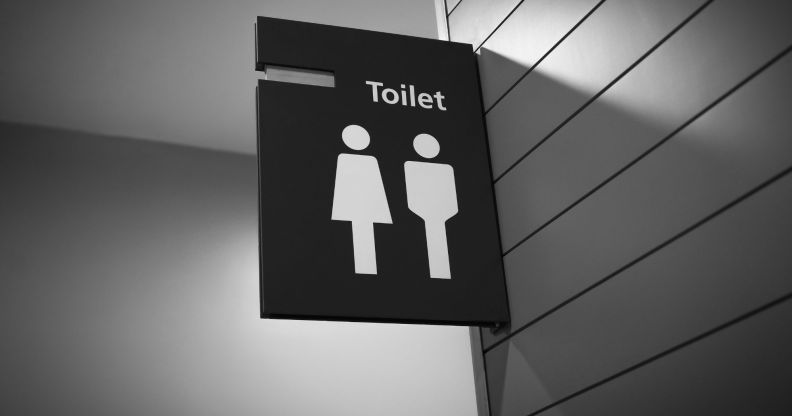UK government announces crackdown on gender-neutral toilets

Gender neutral toilets will be scrapped in all new builds, according to an upcoming government policy. (Getty)
The UK government has today announced a new building requirement which will prevent gender-neutral toilets in new, non-residential buildings.
A policy announced on Sunday (13 August) as part of the government’s Levelling Up scheme revealed requirements for all new builds to separate male and female toilets, which it argues is to “protect single-sex spaces”.
“The change comes amid dignity and privacy concerns from women and elderly people who feel they are being unfairly disadvantaged as publicly accessible toilets are increasingly being converted into gender-neutral facilities,” the statement alleges.
Pro-LGBTQ+ activists have previously signalled the importance of gender-neutral toilets, including conservative MP Caroline Nokes, who said in 2022 that the “inclusive” facilities are something she stands up for “enormously.“
Following the policy’s announcement, Nokes told PinkNews: “What matters most when it comes to toilets is design. I always point at Portcullis House in Parliament which has bathrooms on every floor, nobody refers to them as gender-neutral bathrooms – they are just bathrooms.
“If you have lavatory facilities that are each self-contained units, with their own wash basin and hand drier, and wall-to-ceiling walls and doors, and men remember to put the seat down, there really is nothing to complaint about,” she continued.
“What we all want is nice, clean, private loos, and in new builds in particular that ought not to be impossible.”
Under the new requirement, building plans in England will require “separate single-sex toilets” for men and women, while “self-contained, private toilets,” which the government are called universal toilets, are provided to ensure “privacy and safety”
Mixed-sex shared facilities are reportedly “not an option” under the new proposed policy, except in rare circumstances.
A consultation into the guidance will reportedly consider how the policy could impact groups protected under the 2010 Equality Act and will take a wide variety of views into consideration.
The government has made no suggestion whether the plans will extend to Scotland, Wales, or Northern Ireland in the future.
Women and equalities minister Kemi Badenoch wrote in The Telegraph on Sunday that she believed the policy would contribute to the “privacy and dignity” of members of the public when using facilities.
“These proposals will ensure every new building in England is required to provide separate male and female or unisex facilities and publish guidance to explain the difference, protecting the dignity, privacy and safety for all,” she wrote.
Badenoch had previously signalled her stance on removing gender-neutral toilets in 2022 during the Tory leadership campaign.
The new proposed building guidelines will not apply to ensuite facilities in residential rooms and care homes.
Separate facilities for boys and girls aged eight years or over is already a policy in England, though the government has said the policy consultation will “reinforce the principle”.
Parliamentary undersecretary of state for faith and communities, Baroness Jane Scott, said that a call for evidence had gathered 17,000 responses, which she said “represented a full range of views”.
According to a recent YouGov opinion tracker, as of Wednesday (9 August), 47 per cent of women in the UK oppose gender-neutral toilets, while a separate 47 per cent of women support having gender-neutral toilets as well as separate toilets for men and women. The remaining six per cent support gender-neutral toilets only, or do not know.
People aged 18-24 are more strongly in favour of including gender-neutral toilets (51 per cent), while 34 per cent oppose them.
Trans activists reacted to the news with dismay on social media, with some asking why the Conservative government were choosing to prioritise removing gender-neutral loos over other issues in the UK.
One social media user wrote that the UK public “can’t pay our rent, mortgages, fuel bills, or buy food”, while arguing that the government was too focused on “sex-segregated lavatories”.
“When reading these stories, please remember that it’s not trans people who are any threat,” another user wrote. “Please also remember that when there are no gender-neutral toilets it can often lead to me having no safe options.”
A spokesperson for the trans-led organisation We Exist told VICE last year that the government’s stance on gender-neutral toilets is an attempt to “exclude, alienate and discriminate against” trans and non-binary people.
“There is also little to no evidence that cisgender women feel unsafe in current provided facilities so we are concerned that the government is creating a false narrative by which to exclude trans and gender non-conforming people.”
Information provided to PinkNews by the Department for Levelling Up explained that the policy did not preclude gender-neutral facilities, but that single-sex facilities must be provided as a minimum.
The proposed changes are like to come into force in 2024 after the consultation and a subsequent transition period is completed, which will involve considerations for trans and non-binary individuals.
The building regulation policies will not dictate the management of the facilities, but rather the requirements for their construction.
PinkNews has approached Kemi Badenoch for comment.

